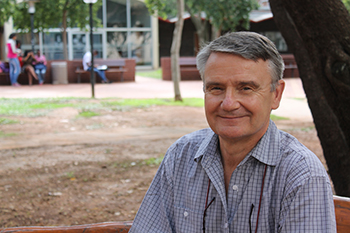
Prof Schall, head of the UFS Statistical Consultation Unit
Photo: Leonie Bolleurs
Whether it is analysing data on church attendance, climate change in the Northern Cape or injuries among elite female hockey players, the Statistical Consultation Unit at the University of the Free State (UFS) can assist researchers from the planning of research to publication therof.
Many students and researchers think that the time to consult a statistician is after their research data has been collected. According to Prof Robert Schall, head of the unit, the most significant contribution a statistician can make to a research project is often during its planning. Preferably all researchers should consult the unit early in the research process.
Statistical consultation service free for postgraduates
The consultation unit, established in 2014 in the Department of Mathematical Statistics and Actuarial Science, provides support to all UFS researchers. This service is rendered to postgraduate students at no charge.
“The unit can make a contribution throughout the research process, from the planning of the research project, through the analysis of research data, up to the publication of the findings. I have been involved in projects where, for example, a few very simple changes to the design of a questionnaire would have saved the researcher and the statistician a lot of trouble. It will be beneficial for researchers to have their questionnaires and study proposals (where relevant), reviewed by a statistician,” Prof Schall said.
“The unit can make a contribution
throughout the research process,
from the planning of the research
project, through the analysis of
research data, up to the publication
of the findings.”
Fascinating research topics deliver fascinating data
The professor assisted in a study for the Department of Soil, Crop and Climate Sciences to determine whether rainfall in the Northern Cape had changed over the past 90 years, potentially indicating climate change.
Other interesting projects he has worked on came from the Department of Exercise and Sport Sciences. “Who will not be fascinated by data sets on aspects of rugby, cricket or even netball? One significant finding was a predictor of injury in elite female hockey players. The PhD student identified a pre-season test which predicted the occurrence of an in-season injury with 100% specificity and 100% sensitivity. The finding was quite surprising, and, if the results can be replicated, obviously would be useful in the prevention of injuries,” he said.
This is, of course, not an exhaustive list of projects the unit has worked on. “Not in my wildest dreams would I have expected to be involved in projects coming from the Faculty of Theology, or from the Odeion School of Music,” Prof Schall said.